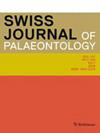The history of palaeontological research and excavations at Monte San Giorgio
IF 3
2区 地球科学
Q1 PALEONTOLOGY
引用次数: 0
Abstract
There is a long history of palaeontological excavations at Monte San Giorgio (Switzerland) and the adjoining Monte Pravello—Monte Orsa (Italy), aimed at finding well-preserved skeletons of Middle Triassic vertebrates. The first fossils were discovered in the mid-Nineteenth Century during mining of black shales (scisti bituminosi) near Besano, Italy, with further finds in the early Twentieth Century through industrial-scale mining. Studies of the material generated international interest and prompted formal palaeontological excavations on both sides of the border. The earliest excavations took place in 1863 and 1878, with the most extensive between 1924 and 1968. Systematic excavations have continued up to the present day, focusing on six distinct fossiliferous horizons: the Besano Formation and the overlying Meride Limestone with the Cava inferiore, Cava superiore, Cassina, Sceltrich and Kalkschieferzone beds. All these have provided material for study and display, with Monte San Giorgio itself recently designated a UNESCO World Heritage Site. The workers and organisations involved, locations excavated and material recovered are described herein.圣乔治山古生物研究和发掘史
在圣乔治山(瑞士)和毗邻的普拉韦洛山-蒙特奥尔萨(意大利)进行古生物发掘的历史悠久,目的是寻找保存完好的三叠纪中期脊椎动物骨骼。第一批化石是十九世纪中叶在意大利贝萨诺附近开采黑色页岩(scisti bituminosi)时发现的,二十世纪初通过工业规模的开采又有新的发现。对这些材料的研究引起了国际兴趣,并促使边境两侧进行了正式的古生物发掘。最早的发掘发生在 1863 年和 1878 年,最大规模的发掘发生在 1924 年至 1968 年。系统的发掘工作一直持续到今天,主要集中在六个不同的化石地层:贝萨诺地层和上覆的梅里德石灰岩层,以及卡瓦下层、卡瓦上层、卡西纳层、斯凯尔特里希层和卡克施费尔宗层。所有这些都为研究和展示提供了素材,圣乔治山本身最近也被联合国教科文组织列为世界遗产。本文介绍了参与其中的工作人员和组织、发掘地点和出土材料。
本文章由计算机程序翻译,如有差异,请以英文原文为准。
求助全文
约1分钟内获得全文
求助全文
来源期刊

Swiss Journal of Palaeontology
Earth and Planetary Sciences-Paleontology
CiteScore
4.30
自引率
16.70%
发文量
17
审稿时长
4 weeks
期刊介绍:
The Swiss Journal of Palaeontology publishes original research and review articles of interest to the international community in the fields of palaeontology, taxonomy and systematics, while recognising at the same time the importance of documenting high-quality palaeontological data in a regional context. Palaeobiology in combination with alpha taxonomy is a core topic of the journal.
Submitted papers should have an appeal as wide as possible, directed towards an international readership. Contributions should not have been simultaneously submitted elsewhere, and the overlap of content between related articles should be minimal. Duplications of text and the use of previously published illustrations without adequate citation are unacceptable. If a manuscript has two or more authors, both or all have to sign to confirm they all were involved in the work and have agreed to its submission. The preferred manuscript language is UK English, but consistently used US English is also acceptable. We encourage the publication of proceedings of international meetings as well as special thematic issues. Short contributions and book reviews are also accepted.
An international editorial team as well as guest editors guarantee that the thematic issues as well as all articles in regular issues are peer-reviewed and meet the highest standards.
 求助内容:
求助内容: 应助结果提醒方式:
应助结果提醒方式:


